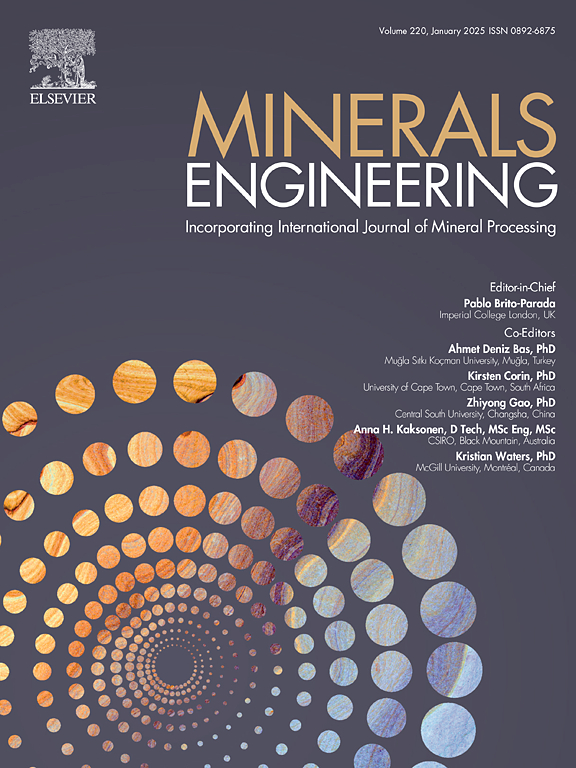细胞色素2在淡水和盐水中酸性氧化亚铁硫杆菌对黄铁矿的粘附作用的实验和计算研究
IF 4.9
2区 工程技术
Q1 ENGINEERING, CHEMICAL
引用次数: 0
摘要
酸性氧化亚铁硫杆菌的使用正在成为提高铜矿浸出和浮选性能的一种替代方法。这种细菌附着在黄铁矿等矿物质上,使其氧化,从而促进其在浸出过程中的溶解和浮选过程中的抑制。酸性氧化亚铁硫杆菌通过细胞色素2与黄铁矿相互作用,细胞色素2是一种诱导氧化的膜蛋白。在这项工作中,我们使用基于泊松-玻尔兹曼方程和具有原子分辨率的Lennard-Jones势的数值模型,对细胞色素2在酸性氧化亚铁硫杆菌粘附在淡水和咸水中黄铁矿中的作用进行了实验和计算研究。我们的研究结果表明,黄铁矿和细胞色素2之间的静电相互作用决定了酸性氧化亚铁硫杆菌整体粘附的pH依赖性。此外,我们发现在低盐度下,静电相互作用由蛋白质和黄铁矿表面的总电荷主导,然而,高盐浓度下的屏蔽效应使局部相互作用更加相关,从而改变了粘附峰值的pH值。本研究为合理调整条件,优化生物试剂浸出浮选工艺提供了理论依据。本文章由计算机程序翻译,如有差异,请以英文原文为准。
An experimental and computational study of the role of cytochrome 2 in the adhesion of Acidithiobacillus ferrooxidans to pyrite in fresh and saline water
The use of Acidithiobacillus ferrooxidans is emerging as an alternative to enhance the performance of leaching and flotation in copper mining. This bacterium adheres to minerals like pyrite, oxidizing it, which facilitates its dissolution in leaching and depression in flotation. Acidithiobacillus ferrooxidans interacts with pyrite through Cytochrome 2, a membrane protein that induces oxidation. In this work we performed an experimental and computational study of the role of Cytochrome 2 in the adhesion of Acidithiobacillus ferrooxidans to pyrite in fresh and saline water, using a numerical model based on the Poisson-Boltzmann equation and the Lennard-Jones potential that has atomic resolution. Our results indicate that the electrostatic interaction between pyrite and Cytochrome 2 dictates the pH dependence of the adhesion of Acidithiobacillus ferrooxidans as a whole. Also, we found that at low salinity the electrostatic interaction is dominated by the total charge of both the protein and the pyrite surface, however, the shielding effect at higher salt concentrations makes local interactions more relevant, which modifies the pH at which adhesion peaks. This work serves as motivation to rationally tune conditions to optimize the leaching and flotation processes through biological reagents.
求助全文
通过发布文献求助,成功后即可免费获取论文全文。
去求助
来源期刊

Minerals Engineering
工程技术-工程:化工
CiteScore
8.70
自引率
18.80%
发文量
519
审稿时长
81 days
期刊介绍:
The purpose of the journal is to provide for the rapid publication of topical papers featuring the latest developments in the allied fields of mineral processing and extractive metallurgy. Its wide ranging coverage of research and practical (operating) topics includes physical separation methods, such as comminution, flotation concentration and dewatering, chemical methods such as bio-, hydro-, and electro-metallurgy, analytical techniques, process control, simulation and instrumentation, and mineralogical aspects of processing. Environmental issues, particularly those pertaining to sustainable development, will also be strongly covered.
 求助内容:
求助内容: 应助结果提醒方式:
应助结果提醒方式:


